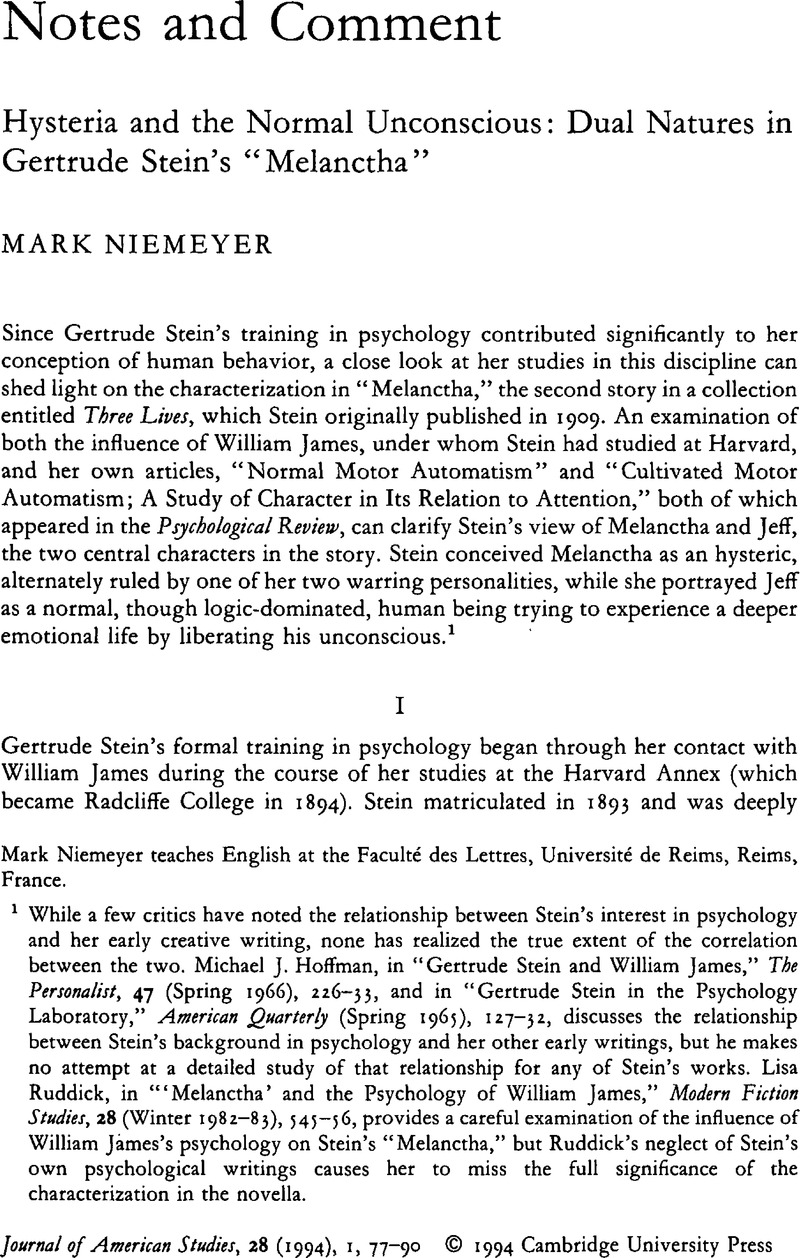Published online by Cambridge University Press: 16 January 2009

1 While a few critics have noted the relationship between Stein's interest in psychology and her early creative writing, none has realized the true extent of the correlation between the two. Hoffman, Michael J., in “Gertrude Stein and William James,” The Personalist, 47 (Spring 1966), 226–33Google Scholar, and in “Gertrude Stein in the Psychology Laboratory,” American Quarterly (Spring 1965), 127–32Google Scholar, discusses the relationship between Stein's background in psychology and her other early writings, but he makes no attempt at a detailed study of that relationship for any of Stein's works. Lisa Ruddick, in “‘Melanctha’ and the Psychology of William James,” Modern Fiction Studies, 28 (Winter 1982–1983), 545–56Google Scholar, provides a careful examination of the influence of William James's psychology on Stein's “Melanctha,” but Ruddick's neglect of Stein's own psychological writings causes her to miss the full significance of the characterization in the novella.
2 Hobhouse, Janet, Everybody Who Was Anybody: A Biography of Gertrude Stein (New York: G. P. Putnam's Sons, 1975), 16–17Google Scholar.
3 In this study, I am interested in Stein's conception of hysteria and the normal unconscious and not in a modern clinical view of these topics. It is Stein's ideas, formed during her study with James and her own psychological investigations, that I wish to show had a significant impact on “Melanctha.”
4 James, William, The Principles of Psychology, 2 vols. (1890; rept. New York: Henry Holt and Company, 1923), 1, 417Google Scholar.
5 Ibid., 417.
6 Ibid., 660.
7 Ibid., 671.
8 Ey, Henri, “History and Analysis of the Concept,” Hysteria, ed. Roy, Alec (New York: John Wiley & Sons, 1982), 7Google Scholar.
9 James, 210.
10 Solomons, Leon M. and Stein, Gertrude, “Normal Motor Automatism,” The Psychological Review, 3 (1896), 492–93CrossRefGoogle Scholar.
11 Ibid., 508.
12 Ibid., 510–11.
13 Stein, Gertrude, “Cultivated Motor Automatism; A Study of Character in Its Relation to Attention,” The Psychological Review, 5 (1898), 305CrossRefGoogle Scholar.
14 Stein, Gertrude, Three Lives (1909; rept. New York: Vintage, 1936), 86Google Scholar.
15 Ibid., 110.
16 Ruddick, “‘Melanctha’ and the Psychology of William James,” 547.
17 Ibid., 547.
18 Stein, , Three Lives, 97Google Scholar.
19 Ibid., 104.
20 Ibid., 108.
21 Ibid., 184.
22 Ibid., 92.
23 Ibid., 111.
24 Ibid., 116.
25 Ibid., 107.
26 Ibid., 178.
27 Ibid., 202.
28 Saunders, Judith P., “Bipolar Conflict in Stein's ‘Melanctha,’” Modern Language Studies, 15 (1985), 56CrossRefGoogle Scholar.
29 Support for this view can be found in Q.E.D. [in Fernhurst, Q.E.D., and Other Early Works (New York: Liveright, 1971)Google Scholar], an earlier version of “Melanctha” which Stein wrote in 1903. In the lesbian relationship described in Q.E.D., it is directly suggested that Helen, the character who would be reworked into Melanctha, is an hysteric. Adele, the precursor of Jeff, says to Helen: “you are a wonderful example of double personality” (81). Later the laboratory atmosphere is recalled when Helen charges Adele with clinical coldness. “You should give your subjects occasional respite even in the ardor of research,” she states indictingly (82). Such terminology reveals both that Stein may have considered Helen as an hysteric in creating her character and that Stein's laboratory experiments were not far from her mind during the novella's composition. Of course, Q.E.D. underwent a transformation before becoming “Melanctha,” but the original intentionality implied in the statements of Adele and Helen support a reading of the later story informed by Stein's background in psychology.
30 Stein, , Three Lives, 106Google Scholar.
31 Ibid., 107.
32 Ibid., 131.
33 Ibid., 134.
34 Ibid., 136.
35 Ibid., 154.
36 Ibid., 207.
37 Ibid., 138.
38 Ibid., 175.
39 Ibid., 132.
40 Ibid., 135.
41 Ibid., 144.
42 Ibid., 149.
43 Ibid., 154.
44 Ibid., 206.
45 Saunders, “Bipolar Conflict,” 59.